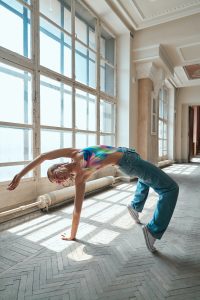 You have to have all four types of fitness training to become fit. They include balance, strength, endurance and flexibility. We provide all types of training at Next Level Fitness in Irvine, CA. Flexibility training is important to help prevent injury and can make moves you do daily easier on your body and more enjoyable. Increasing your flexibility takes more than just stretching occasionally. It takes constant effort and knowing the right way to increase flexibility.
You have to have all four types of fitness training to become fit. They include balance, strength, endurance and flexibility. We provide all types of training at Next Level Fitness in Irvine, CA. Flexibility training is important to help prevent injury and can make moves you do daily easier on your body and more enjoyable. Increasing your flexibility takes more than just stretching occasionally. It takes constant effort and knowing the right way to increase flexibility.
Flexibility starts with a warm-up and ends with cool down exercises.
There are several types of stretches to help increase flexibility: dynamic, static, ballistic, myofascial release and active isolated stretching. All play a role in flexibility and all are different, not only in how they’re done, but also when they’re done. Some types of stretching are better for warming up, while others are better for overall flexibility. Some help protect muscles when doing other exercises and others help muscles heal. Dynamic stretching is a great warm up exercise that can protect muscles, but those exercises can cause more harm than benefit if used when you’re rehabbing from an injury.
Do dynamic stretches before a workout to improve flexibility by warming muscles.
The type of dynamic stretching you’ll do is based on the type of workout you’re going to do. The dynamic stretch should warm the muscles you’re about to use when you workout. Dynamic stretches include lunges, jumping jacks and squats. Once those muscles are warmed, near the end of the exercise session, static or passive stretching can help improve range of motion—flexibility.
Active stretching alternates between contracting and relaxing antagonist and agonist muscle groups.
While active or PNF stretching was first used for rehab, it’s often used to help improve flexibility too. It’s more comfortable to do than many types of static stretching and strengthens the muscles while it makes them more flexible. PNF combines isometric stretching and static stretching. You assume the static stretch position, then isometrically tighten your muscles for ten to fifteen seconds, then relax the muscles.
- PNF exercises can include hold-relax movements, contract-relax, hold-relax-contract and rhythmic rotation.
- Don’t try to stretch too far when you’re first working on flexibility training. Start where you’re comfortable. Always warm muscles first before trying static exercises, like toe touching. If you can’t touch your toes, go as far as you can and work toward touching your toes.
- Stay relaxed during stretching exercises. Deep breathing can help keep your body relaxed and aid in making you more successful. It’s why starting an exercise in a comfortable position is also important.
- Our personal trainers will design a program specifically for your needs that ensure you maximize the benefits of all types of stretching and improve your flexibility. Flexibility not only helps prevent injury, it keeps your walk and movements appear more youthful.
For more information, contact us today at Next Level Fitness
